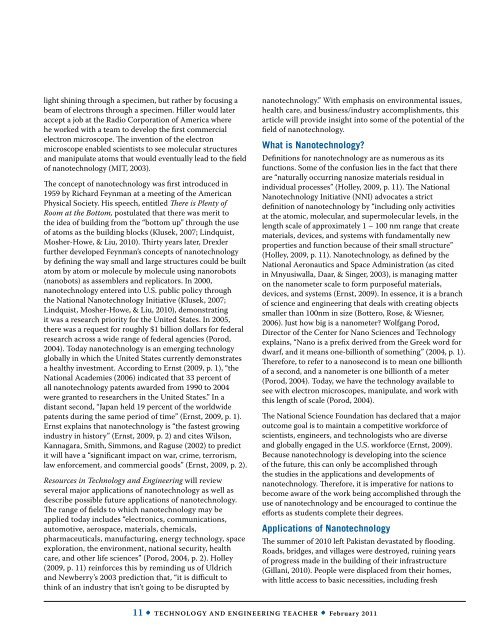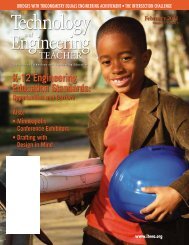March - Vol 70, No 6 - International Technology and Engineering ...
March - Vol 70, No 6 - International Technology and Engineering ...
March - Vol 70, No 6 - International Technology and Engineering ...
Create successful ePaper yourself
Turn your PDF publications into a flip-book with our unique Google optimized e-Paper software.
light shining through a specimen, but rather by focusing a<br />
beam of electrons through a specimen. Hiller would later<br />
accept a job at the Radio Corporation of America where<br />
he worked with a team to develop the first commercial<br />
electron microscope. The invention of the electron<br />
microscope enabled scientists to see molecular structures<br />
<strong>and</strong> manipulate atoms that would eventually lead to the field<br />
of nanotechnology (MIT, 2003).<br />
The concept of nanotechnology was first introduced in<br />
1959 by Richard Feynman at a meeting of the American<br />
Physical Society. His speech, entitled There is Plenty of<br />
Room at the Bottom, postulated that there was merit to<br />
the idea of building from the “bottom up” through the use<br />
of atoms as the building blocks (Klusek, 2007; Lindquist,<br />
Mosher-Howe, & Liu, 2010). Thirty years later, Drexler<br />
further developed Feynman’s concepts of nanotechnology<br />
by defining the way small <strong>and</strong> large structures could be built<br />
atom by atom or molecule by molecule using nanorobots<br />
(nanobots) as assemblers <strong>and</strong> replicators. In 2000,<br />
nanotechnology entered into U.S. public policy through<br />
the National Nanotechnology Initiative (Klusek, 2007;<br />
Lindquist, Mosher-Howe, & Liu, 2010), demonstrating<br />
it was a research priority for the United States. In 2005,<br />
there was a request for roughly $1 billion dollars for federal<br />
research across a wide range of federal agencies (Porod,<br />
2004). Today nanotechnology is an emerging technology<br />
globally in which the United States currently demonstrates<br />
a healthy investment. According to Ernst (2009, p. 1), “the<br />
National Academies (2006) indicated that 33 percent of<br />
all nanotechnology patents awarded from 1990 to 2004<br />
were granted to researchers in the United States.” In a<br />
distant second, “Japan held 19 percent of the worldwide<br />
patents during the same period of time” (Ernst, 2009, p. 1).<br />
Ernst explains that nanotechnology is “the fastest growing<br />
industry in history” (Ernst, 2009, p. 2) <strong>and</strong> cites Wilson,<br />
Kannagara, Smith, Simmons, <strong>and</strong> Raguse (2002) to predict<br />
it will have a “significant impact on war, crime, terrorism,<br />
law enforcement, <strong>and</strong> commercial goods” (Ernst, 2009, p. 2).<br />
Resources in <strong>Technology</strong> <strong>and</strong> <strong>Engineering</strong> will review<br />
several major applications of nanotechnology as well as<br />
describe possible future applications of nanotechnology.<br />
The range of fields to which nanotechnology may be<br />
applied today includes “electronics, communications,<br />
automotive, aerospace, materials, chemicals,<br />
pharmaceuticals, manufacturing, energy technology, space<br />
exploration, the environment, national security, health<br />
care, <strong>and</strong> other life sciences” (Porod, 2004, p. 2). Holley<br />
(2009, p. 11) reinforces this by reminding us of Uldrich<br />
<strong>and</strong> Newberry’s 2003 prediction that, “it is difficult to<br />
think of an industry that isn’t going to be disrupted by<br />
nanotechnology.” With emphasis on environmental issues,<br />
health care, <strong>and</strong> business/industry accomplishments, this<br />
article will provide insight into some of the potential of the<br />
field of nanotechnology.<br />
What is Nanotechnology?<br />
Definitions for nanotechnology are as numerous as its<br />
functions. Some of the confusion lies in the fact that there<br />
are “naturally occurring nanosize materials residual in<br />
individual processes” (Holley, 2009, p. 11). The National<br />
Nanotechnology Initiative (NNI) advocates a strict<br />
definition of nanotechnology by “including only activities<br />
at the atomic, molecular, <strong>and</strong> supermolecular levels, in the<br />
length scale of approximately 1 – 100 nm range that create<br />
materials, devices, <strong>and</strong> systems with fundamentally new<br />
properties <strong>and</strong> function because of their small structure”<br />
(Holley, 2009, p. 11). Nanotechnology, as defined by the<br />
National Aeronautics <strong>and</strong> Space Administration (as cited<br />
in Mnyusiwalla, Daar, & Singer, 2003), is managing matter<br />
on the nanometer scale to form purposeful materials,<br />
devices, <strong>and</strong> systems (Ernst, 2009). In essence, it is a branch<br />
of science <strong>and</strong> engineering that deals with creating objects<br />
smaller than 100nm in size (Bottero, Rose, & Wiesner,<br />
2006). Just how big is a nanometer? Wolfgang Porod,<br />
Director of the Center for Nano Sciences <strong>and</strong> <strong>Technology</strong><br />
explains, “Nano is a prefix derived from the Greek word for<br />
dwarf, <strong>and</strong> it means one-billionth of something” (2004, p. 1).<br />
Therefore, to refer to a nanosecond is to mean one billionth<br />
of a second, <strong>and</strong> a nanometer is one billionth of a meter<br />
(Porod, 2004). Today, we have the technology available to<br />
see with electron microscopes, manipulate, <strong>and</strong> work with<br />
this length of scale (Porod, 2004).<br />
The National Science Foundation has declared that a major<br />
outcome goal is to maintain a competitive workforce of<br />
scientists, engineers, <strong>and</strong> technologists who are diverse<br />
<strong>and</strong> globally engaged in the U.S. workforce (Ernst, 2009).<br />
Because nanotechnology is developing into the science<br />
of the future, this can only be accomplished through<br />
the studies in the applications <strong>and</strong> developments of<br />
nanotechnology. Therefore, it is imperative for nations to<br />
become aware of the work being accomplished through the<br />
use of nanotechnology <strong>and</strong> be encouraged to continue the<br />
efforts as students complete their degrees.<br />
Applications of Nanotechnology<br />
The summer of 2010 left Pakistan devastated by flooding.<br />
Roads, bridges, <strong>and</strong> villages were destroyed, ruining years<br />
of progress made in the building of their infrastructure<br />
(Gillani, 2010). People were displaced from their homes,<br />
with little access to basic necessities, including fresh<br />
11 • <strong>Technology</strong> <strong>and</strong> <strong>Engineering</strong> Teacher • February 2011
















